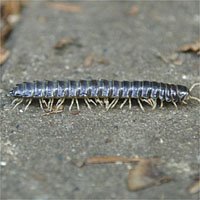キシャヤスデの大発生 Galleyworms
大垪和にも現れた,今年!
キシャヤスデは8年ごとに大発生するといわれています.
大発生の翌年に産卵し,年内に孵化し,毎年1回ずつ脱皮します.7回脱皮(8年目)して成体となり,再び大発生するのです.大発生した場合には,1平方メートルあたり密度は200匹を超え,時には1000匹を越えることもあるといわれます.
キシャヤスデの大発生
長野県野辺山で大発生したキシャヤスデ
いくら掃除してもすぐにまだ十匹があらわれます。
ooo ooo ooo ooo ooo ooo ooo ooo ooo
© Japan Times Wednesday, July 26, 2006
Galleyworm
By ROWAN HOOPER
* Japanese name: Baba-yasude
* Scientific name: Parafontaria species
* Description:
Galleyworms are not worms but millipedes: elongated, cylindrical arthropods, with two pairs of legs on each body segment. Millipede means "1,000 legs" but these species have around 20 body segments, so therefore about 40 pairs of legs. Galleyworms are dark brown to black, and 15 to 20 mm long.
* Where to find them:
Often underground in deciduous woodland and scrub, and under stones and rotting logs. Millipedes are only able to move slowly on their numerous short legs, but they burrow well, moving the body and legs in a powerful wave. They take care about safety, constructing their tunnels to be stable.
* Food:
Decaying leaves, and other bits of plant detritus. Galleyworms are not generally well-liked in Japan, but unlike some of their cousins the centipedes, they are not poisonous, and perform an essential recycling job -- a job which underpins the health of every deciduous forest on the planet. Still, millipedes eat in a rather unpleasant way, secreting fluid onto their food to moisturize it, then chewing up the plant material with one set of mouthparts, and scraping up the sticky pulp with a second set.
* Special features:
Millipedes are primitive insects, but have some interesting evolutionary specializations.
There is a sensory organ called the Tomosvary organ on the head. It forms a raised ring or a horse-shoe shape located behind the antenna sockets. It is probably used when digging and searching for food, as it can measure the humidity in the environment, and probably some other chemicals too. They also have simple eyes at the side of the head, as well as the two main eyes at the front, and sensory antennae.
In the distant past, they used to have just one pair of legs on each body segment, like centipedes do today, but two single segments fused over millions of years, and now each segment carries two pairs of legs. Because they don't move fast, if disturbed they may curl into a protective ball, and even emit noxious hydrogen cyanide through pores on the segments. A millipede species currently holds the record for being the first known land animal. That creature was 1 cm long, and lived in what is now Scotland, some 430 million years ago. It is not known if it fought with its fellow millipedes in the south, in what would eventually become England.

PHOTO COURTESY OF BIO-IMAGE NET
http://search.japantimes.co.jp/cgi-bin/fe20060726at.html
:::::::::::::::::::::::::::::::::::::::::::::::::::::::::::::::::::::::::::::::::::::::::::::::::::::
mukade 百足 ムカデ cenitpede, 100 legs
2020 May 02
first mukade in the bathroom
first gejigeji in the bath water
. mukade and Haiku .
- #mukade #centipede #gejigeji -
:::::::::::::::::::::::::::::::::::::::::::::::::::::::::::::::::::::::::::::::::::::::::::::::::::::
大垪和 。。。道の駅に戻る – Michi no Eki - BACK
:::::::::::::::::::::::::::::::::::::::::::::::::::::::::::::::::::::::::::::::::::::::::::::::::::::
worldkigo





No comments:
Post a Comment